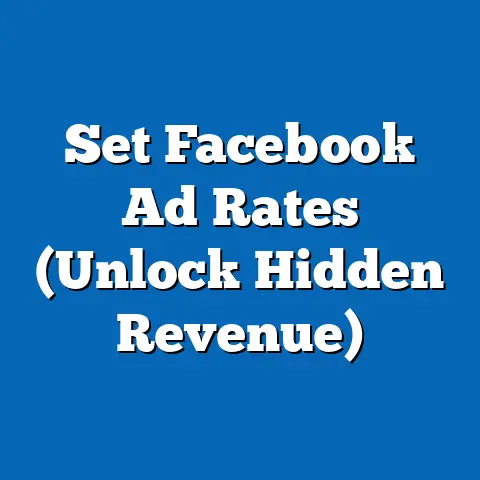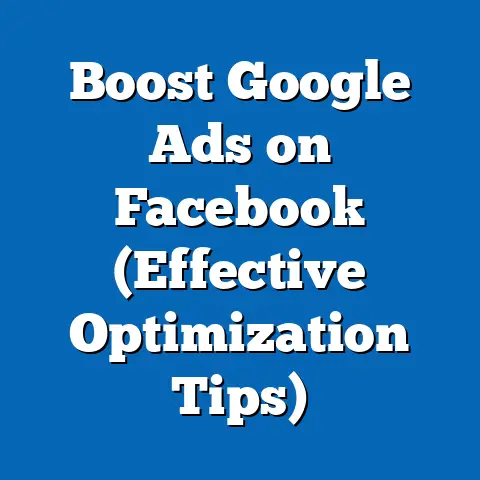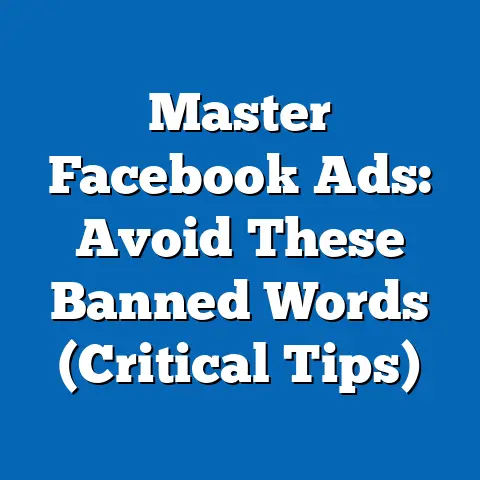Reviving Disabled Facebook Ad Account (Expert Recovery Tips)
Have you ever poured time and resources into crafting the perfect Facebook ad campaign, only to have your account disabled without warning? I know that feeling all too well. It’s like building a sandcastle only to have the tide wash it away. The frustration, the confusion, the sheer panic – it’s a gut punch. But don’t despair! I’ve been there, helped others navigate it, and I’m here to tell you there’s often a way back.
Section 1: Understanding Facebook’s Ad Policies
Facebook’s advertising policies are the bedrock of its advertising ecosystem. They’re designed to protect users, maintain a positive platform experience, and ensure fair and ethical advertising practices. These policies cover a broad range of topics, from ad content and targeting to data privacy and prohibited products or services.
Think of these policies as the rulebook of a very complex game. And like any rulebook, it’s constantly evolving. I’ve seen firsthand how even seasoned advertisers can inadvertently stumble upon violations due to changes in policy or misinterpretations of existing guidelines.
Common Reasons for Account Disablement:
- Violations of Ad Content: This is the most common reason. It includes ads that are misleading, deceptive, or make unrealistic claims. For example, ads promising guaranteed weight loss or claiming to cure diseases are clear violations.
- Misleading Information: Ads must be truthful and accurate. Any attempts to deceive users with false information about products, services, or business practices can lead to account disablement. Think about those “get rich quick” schemes – Facebook is on high alert for those.
- Prohibited Products/Services: Facebook prohibits the promotion of certain products and services, including illegal drugs, firearms, and tobacco products. Even seemingly harmless items, like certain dietary supplements, can trigger policy violations if they contain prohibited ingredients or make unsubstantiated health claims.
- Circumventing Systems: Trying to trick Facebook’s ad review system or using cloaking techniques to hide the true destination of your ads is a surefire way to get your account disabled. Be upfront and transparent about what you’re advertising.
- Unacceptable Business Practices: Facebook scrutinizes business practices as well. If your website has a poor user experience, lacks clear contact information, or engages in deceptive billing practices, your ad account could be at risk.
- Targeting Issues: While Facebook’s targeting options are powerful, they can also be misused. Ads that discriminate against protected groups (e.g., based on race, religion, or sexual orientation) are strictly prohibited.
The Frequency and Impact of Account Disablement:
While Facebook doesn’t release exact figures on account disablements, industry experts estimate that thousands of accounts are disabled every day. This can have a devastating impact on businesses that rely on Facebook advertising for lead generation, sales, and brand awareness.
I’ve personally witnessed the frustration and financial losses experienced by clients whose accounts were suddenly disabled. One client, a small e-commerce business, saw their sales plummet by 70% after their ad account was suspended. The lost revenue, combined with the time and effort required to appeal the decision, put a significant strain on their business.
Key Takeaway: Understanding Facebook’s advertising policies is crucial for avoiding account disablement. Regularly review the policies and ensure that your ads comply with all applicable guidelines.
Section 2: Initial Steps to Take After Account Disabling
So, you’ve received the dreaded notification: your Facebook ad account has been disabled. What do you do next? The first few steps you take are critical in determining whether you can successfully recover your account.
Immediate Actions:
- Don’t Panic: It’s natural to feel frustrated and stressed, but panicking won’t help. Take a deep breath and approach the situation calmly and methodically.
- Review the Notification: Facebook usually provides a reason for the disablement in the notification. Read it carefully and try to understand which policy you may have violated. This is your starting point for understanding the issue.
- Document Everything: Take screenshots of the notification, your ads, and any relevant information about your account. This documentation will be helpful when you file your appeal.
- Avoid Making Hasty Changes: Resist the urge to immediately delete or edit your ads. Preserving the original state of your account and ads is important for the review process.
The Importance of Objectivity:
It’s easy to become defensive when you believe your account was unfairly disabled. However, it’s important to approach the situation objectively. Try to see things from Facebook’s perspective. Are there any aspects of your ads or business practices that could be misinterpreted as policy violations?
I remember working with a client who was convinced that their account was disabled due to a competitor’s malicious reporting. While that’s certainly a possibility, it’s more likely that there was a genuine policy violation. After carefully reviewing their ads, we discovered that one of them made an unsubstantiated claim about the effectiveness of their product.
Key Takeaway: Stay calm, review the notification carefully, document everything, and approach the situation objectively.
Section 3: The Appeal Process
The appeal process is your opportunity to present your case to Facebook and request a review of their decision. It’s crucial to approach this process strategically and provide compelling evidence to support your appeal.
Step-by-Step Guide to Appealing:
- Access the Appeal Form: Typically, there will be a button or link within the notification that directs you to the appeal form. If not, you can usually find it in the Facebook Business Help Center.
- Provide Accurate Information: Fill out the appeal form completely and accurately. Be honest about your business practices and avoid making excuses or blaming others.
- Explain Your Understanding of the Violation: Demonstrate that you understand the reason for the disablement and acknowledge any mistakes you may have made. This shows Facebook that you’re taking the issue seriously.
- Explain How You’ve Rectified the Issue: Outline the steps you’ve taken to correct the violation and ensure that it won’t happen again. This could include editing your ads, updating your website, or implementing new internal policies.
- Provide Supporting Evidence: Include any evidence that supports your appeal, such as screenshots of your ads, account history, compliance certifications, or testimonials from satisfied customers.
- Be Professional and Respectful: Frame your appeal message in a professional and respectful tone. Avoid using aggressive language or making demands. Remember, you’re trying to persuade Facebook to reconsider their decision.
- Submit Your Appeal: Once you’ve completed the appeal form and gathered your supporting evidence, submit your appeal. Be patient, as it can take several days or even weeks for Facebook to review your appeal.
Framing Your Appeal Message:
The way you frame your appeal message can significantly impact its effectiveness. Here are some tips:
- Start with an Apology: Acknowledge that you understand the importance of Facebook’s advertising policies and apologize for any unintentional violations.
- Take Responsibility: Don’t try to deflect blame or make excuses. Take responsibility for your actions and demonstrate a commitment to compliance.
- Highlight Your Positive Track Record: If you have a history of running successful and compliant ad campaigns, highlight this in your appeal.
- Focus on Solutions: Instead of dwelling on the problem, focus on the solutions you’ve implemented to prevent future violations.
- Express Gratitude: Thank Facebook for their time and consideration, and express your commitment to being a responsible advertiser.
Key Takeaway: Approach the appeal process strategically, provide accurate information, explain your understanding of the violation, offer solutions, and maintain a professional tone.
Section 4: Common Mistakes to Avoid During the Recovery Process
While appealing a disabled Facebook ad account, avoiding common pitfalls is crucial. I’ve seen many advertisers inadvertently sabotage their chances of recovery by making these mistakes.
Typical Pitfalls:
- Submitting Multiple Appeals: Resist the urge to submit multiple appeals. This can overwhelm Facebook’s review team and actually slow down the process. Focus on crafting a single, compelling appeal with all the necessary information.
- Using Aggressive Language: As tempting as it may be to vent your frustration, using aggressive or demanding language in your appeal will only hurt your chances of success. Maintain a professional and respectful tone.
- Creating a New Account While the Previous One is Disabled: This is a major violation of Facebook’s policies. Facebook explicitly prohibits creating multiple accounts to circumvent restrictions. Doing so can lead to the permanent disablement of all your accounts. I had a client who did this, thinking they were being clever, and it resulted in a permanent ban from the platform.
- Ignoring Facebook’s Communication: If Facebook requests additional information or clarification, respond promptly and thoroughly. Ignoring their communication can be interpreted as a lack of cooperation.
- Failing to Address the Underlying Issue: Simply apologizing for the violation isn’t enough. You need to demonstrate that you understand the underlying issue and have taken steps to prevent it from happening again.
- Being Impatient: The appeal process can take time. Be patient and avoid constantly contacting Facebook for updates. Trust that they are reviewing your appeal and will notify you of their decision.
The Importance of Patience and Persistence:
Recovering a disabled Facebook ad account can be a long and challenging process. It requires patience, persistence, and a willingness to learn from your mistakes. Don’t give up easily. Keep refining your appeal, gathering supporting evidence, and demonstrating your commitment to compliance.
Key Takeaway: Avoid common pitfalls, such as submitting multiple appeals, using aggressive language, creating new accounts, ignoring Facebook’s communication, and failing to address the underlying issue. Be patient and persistent throughout the recovery process.
Section 5: Additional Recovery Strategies
Beyond the standard appeal process, there are additional strategies you can employ to increase your chances of recovering your disabled Facebook ad account.
Expert Tips:
- Use Facebook’s Business Support: Facebook offers a Business Support portal where you can connect with a support representative who can provide guidance and assistance with your appeal. This can be particularly helpful if you’re unsure about the reason for the disablement or need help crafting your appeal message.
- Maintain a Good Account Standing: Even before your account is disabled, maintaining a good account standing can help expedite the recovery process. This includes running compliant ad campaigns, responding promptly to Facebook’s communications, and engaging with the Facebook community.
- Check Your Facebook Page Quality: Your Facebook Page’s quality score can impact your ad account’s health. Ensure your Page complies with Facebook’s Page policies, has accurate information, and provides a positive user experience.
- Engage with Facebook’s Community: Joining Facebook groups and forums dedicated to advertising can provide valuable insights into common issues and solutions. You can also learn from other advertisers’ experiences and get advice on crafting your appeal.
- Consider Consulting with a Facebook Ads Expert: If you’re struggling to recover your account on your own, consider consulting with a Facebook Ads expert who has experience navigating the appeal process. They can provide personalized guidance and help you craft a compelling appeal.
The Role of Facebook’s Automated Systems:
It’s important to understand that Facebook’s ad review process is largely automated. This means that your ads are initially reviewed by algorithms that look for potential policy violations. If an algorithm flags your ad, it may be reviewed by a human, but the initial decision is often based on automated analysis.
Understanding this can help you tailor your appeal message to address the specific concerns of the automated system. For example, if your ad was flagged for making unsubstantiated claims, you can provide evidence to support your claims and demonstrate that your ad is not misleading.
Key Takeaway: Utilize Facebook’s Business Support, maintain a good account standing, engage with the Facebook community, and consider consulting with a Facebook Ads expert. Understand the role of Facebook’s automated systems in the review process.
Section 6: Preventing Future Account Disabling
The best way to deal with a disabled Facebook ad account is to prevent it from happening in the first place. By implementing proactive measures, you can minimize the risk of future account issues.
Proactive Measures:
- Regular Policy Reviews: Make it a habit to regularly review Facebook’s advertising policies and community standards. These policies are constantly evolving, so it’s important to stay updated on the latest changes.
- Thorough Testing of Ads: Before launching full campaigns, thoroughly test your ads to ensure that they comply with Facebook’s policies. This includes reviewing your ad copy, images, targeting options, and landing page.
- Use Facebook’s Ad Preview Tool: Facebook offers an ad preview tool that allows you to see how your ad will look on different devices and placements. This can help you identify potential issues with your ad’s formatting or content.
- Monitor Your Account Health: Regularly monitor your account health in the Facebook Ads Manager. This will allow you to identify any potential issues early on and take corrective action before they lead to account disablement.
- Implement Internal Compliance Policies: Develop and implement internal compliance policies to ensure that all your ads comply with Facebook’s advertising policies. This could include training your employees on Facebook’s policies, establishing a review process for all ads, and regularly auditing your account.
- Stay Informed About Common Issues: Stay informed about common issues that can lead to account disablement. This could include joining Facebook groups and forums dedicated to advertising, subscribing to industry newsletters, and attending webinars and conferences.
Engaging with Facebook’s Community:
Engaging with Facebook’s community can provide valuable insights into common issues and solutions. By joining Facebook groups and forums dedicated to advertising, you can learn from other advertisers’ experiences and get advice on crafting compliant ad campaigns.
Key Takeaway: Regularly review Facebook’s policies, thoroughly test your ads, monitor your account health, implement internal compliance policies, and stay informed about common issues. Engage with Facebook’s community to learn from other advertisers’ experiences.
Conclusion
A disabled Facebook ad account can be a frustrating setback, but it’s not the end of the world. By understanding Facebook’s advertising policies, taking a methodical approach to recovery, and implementing proactive measures to prevent future issues, you can get your account reinstated and back to running successful campaigns.
Remember, account disablement is often a learning opportunity. It forces you to re-evaluate your advertising strategies, refine your targeting options, and ensure that your ads comply with Facebook’s policies. By viewing account disablement as a learning opportunity, you can emerge as a more responsible and effective advertiser.
Ultimately, success on Facebook advertising requires a long-term commitment to compliance, ethical advertising practices, and a willingness to adapt to the ever-changing landscape of social media. So, take a deep breath, follow the steps outlined in this guide, and get back to creating amazing ad campaigns that drive results for your business. Good luck!





